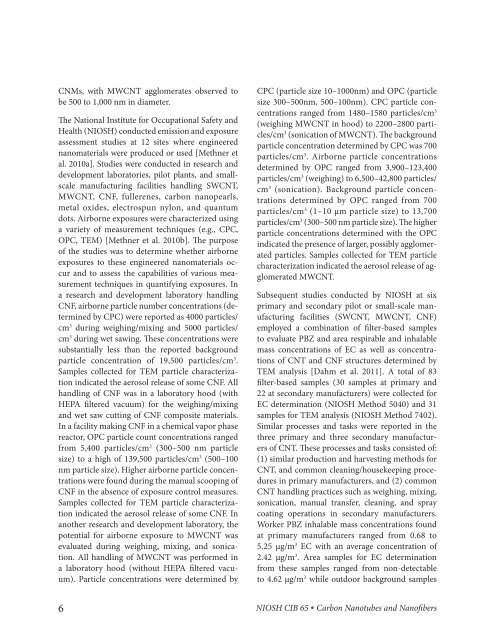Occupational Exposure to Carbon Nanotubes and Nanofibers
Occupational Exposure to Carbon Nanotubes and Nanofibers
Occupational Exposure to Carbon Nanotubes and Nanofibers
Create successful ePaper yourself
Turn your PDF publications into a flip-book with our unique Google optimized e-Paper software.
CNMs, with MWCNT agglomerates observed <strong>to</strong>be 500 <strong>to</strong> 1,000 nm in diameter.The National Institute for <strong>Occupational</strong> Safety <strong>and</strong>Health (NIOSH) conducted emission <strong>and</strong> exposureassessment studies at 12 sites where engineerednanomaterials were produced or used [Methner etal. 2010a]. Studies were conducted in research <strong>and</strong>development labora<strong>to</strong>ries, pilot plants, <strong>and</strong> smallscalemanufacturing facilities h<strong>and</strong>ling SWCNT,MWCNT, CNF, fullerenes, carbon nanopearls,metal oxides, electrospun nylon, <strong>and</strong> quantumdots. Airborne exposures were characterized usinga variety of measurement techniques (e.g., CPC,OPC, TEM) [Methner et al. 2010b]. The purposeof the studies was <strong>to</strong> determine whether airborneexposures <strong>to</strong> these engineered nanomaterials occur<strong>and</strong> <strong>to</strong> assess the capabilities of various measurementtechniques in quantifying exposures. Ina research <strong>and</strong> development labora<strong>to</strong>ry h<strong>and</strong>lingCNF, airborne particle number concentrations (determinedby CPC) were reported as 4000 particles/cm 3 during weighing/mixing <strong>and</strong> 5000 particles/cm 3 during wet sawing. These concentrations weresubstantially less than the reported backgroundparticle concentration of 19,500 particles/cm 3 .Samples collected for TEM particle characterizationindicated the aerosol release of some CNF. Allh<strong>and</strong>ling of CNF was in a labora<strong>to</strong>ry hood (withHEPA filtered vacuum) for the weighing/mixing<strong>and</strong> wet saw cutting of CNF composite materials.In a facility making CNF in a chemical vapor phasereac<strong>to</strong>r, OPC particle count concentrations rangedfrom 5,400 particles/cm 3 (300–500 nm particlesize) <strong>to</strong> a high of 139,500 particles/cm 3 (500–100nm particle size). Higher airborne particle concentrationswere found during the manual scooping ofCNF in the absence of exposure control measures.Samples collected for TEM particle characterizationindicated the aerosol release of some CNF. Inanother research <strong>and</strong> development labora<strong>to</strong>ry, thepotential for airborne exposure <strong>to</strong> MWCNT wasevaluated during weighing, mixing, <strong>and</strong> sonication.All h<strong>and</strong>ling of MWCNT was performed ina labora<strong>to</strong>ry hood (without HEPA filtered vacuum).Particle concentrations were determined byCPC (particle size 10–1000nm) <strong>and</strong> OPC (particlesize 300–500nm, 500–100nm). CPC particle concentrationsranged from 1480–1580 particles/cm 3(weighing MWCNT in hood) <strong>to</strong> 2200–2800 particles/cm3 (sonication of MWCNT). The backgroundparticle concentration determined by CPC was 700particles/cm 3 . Airborne particle concentrationsdetermined by OPC ranged from 3,900–123,400particles/cm 3 (weighing) <strong>to</strong> 6,500–42,800 particles/cm 3 (sonication). Background particle concentrationsdetermined by OPC ranged from 700particles/cm 3 (1–10 µm particle size) <strong>to</strong> 13,700particles/cm 3 (300–500 nm particle size). The higherparticle concentrations determined with the OPCindicated the presence of larger, possibly agglomeratedparticles. Samples collected for TEM particlecharacterization indicated the aerosol release of agglomeratedMWCNT.Subsequent studies conducted by NIOSH at sixprimary <strong>and</strong> secondary pilot or small-scale manufacturingfacilities (SWCNT, MWCNT, CNF)employed a combination of filter-based samples<strong>to</strong> evaluate PBZ <strong>and</strong> area respirable <strong>and</strong> inhalablemass concentrations of EC as well as concentrationsof CNT <strong>and</strong> CNF structures determined byTEM analysis [Dahm et al. 2011]. A <strong>to</strong>tal of 83filter-based samples (30 samples at primary <strong>and</strong>22 at secondary manufacturers) were collected forEC determination (NIOSH Method 5040) <strong>and</strong> 31samples for TEM analysis (NIOSH Method 7402).Similar processes <strong>and</strong> tasks were reported in thethree primary <strong>and</strong> three secondary manufacturersof CNT. These processes <strong>and</strong> tasks consisted of:(1) similar production <strong>and</strong> harvesting methods forCNT, <strong>and</strong> common cleaning/housekeeping proceduresin primary manufacturers, <strong>and</strong> (2) commonCNT h<strong>and</strong>ling practices such as weighing, mixing,sonication, manual transfer, cleaning, <strong>and</strong> spraycoating operations in secondary manufacturers.Worker PBZ inhalable mass concentrations foundat primary manufacturers ranged from 0.68 <strong>to</strong>5.25 µg/m 3 EC with an average concentration of2.42 µg/m 3 . Area samples for EC determinationfrom these samples ranged from non-detectable<strong>to</strong> 4.62 µg/m 3 while outdoor background samples6 NIOSH CIB 65 • <strong>Carbon</strong> <strong>Nanotubes</strong> <strong>and</strong> <strong>Nanofibers</strong>

















